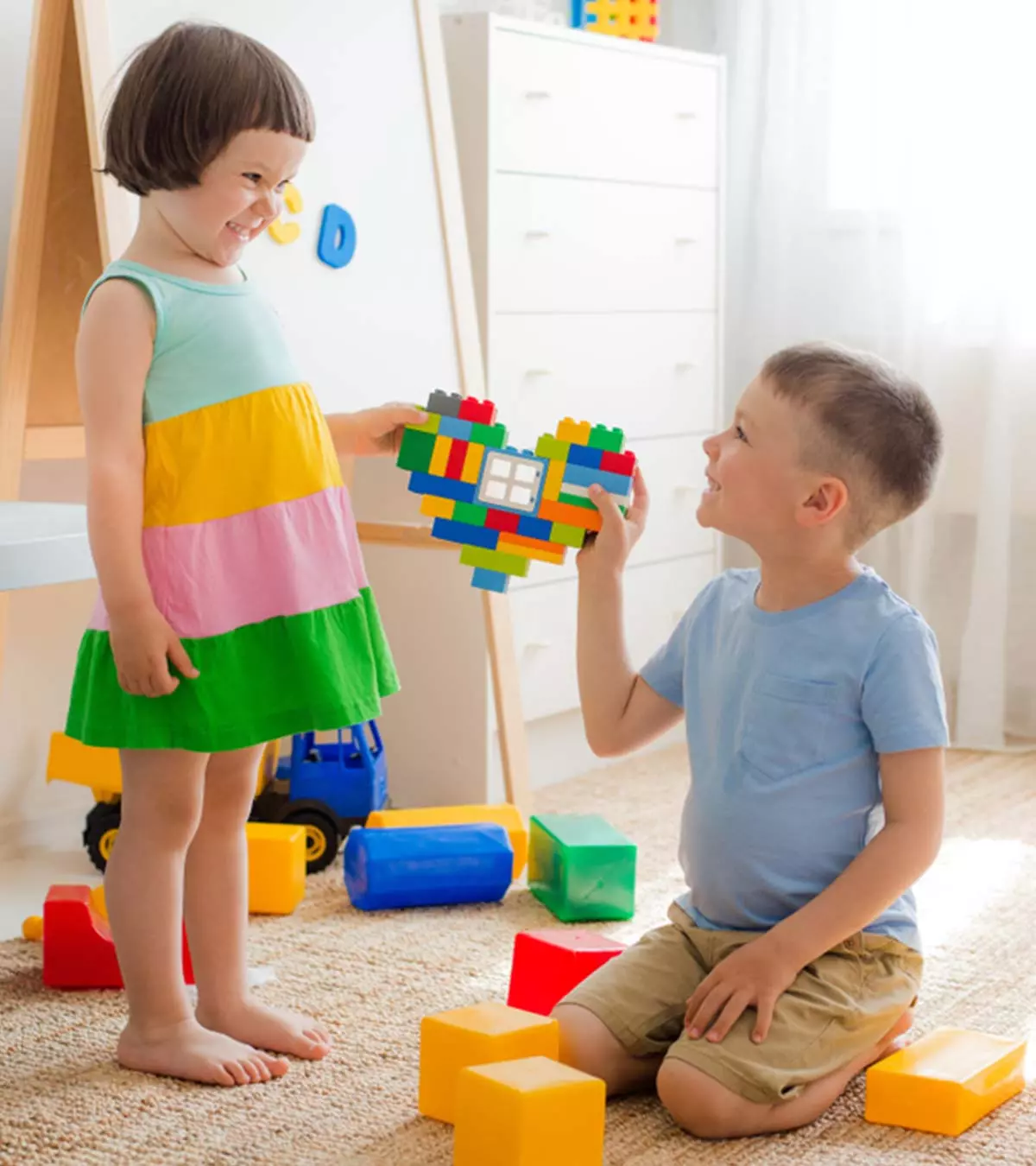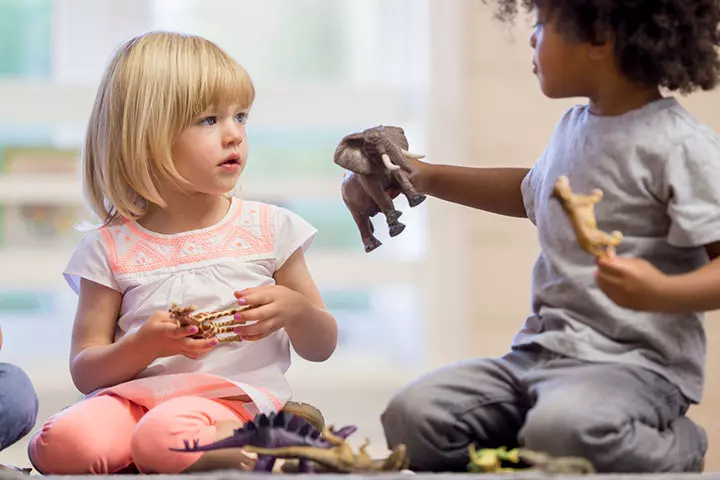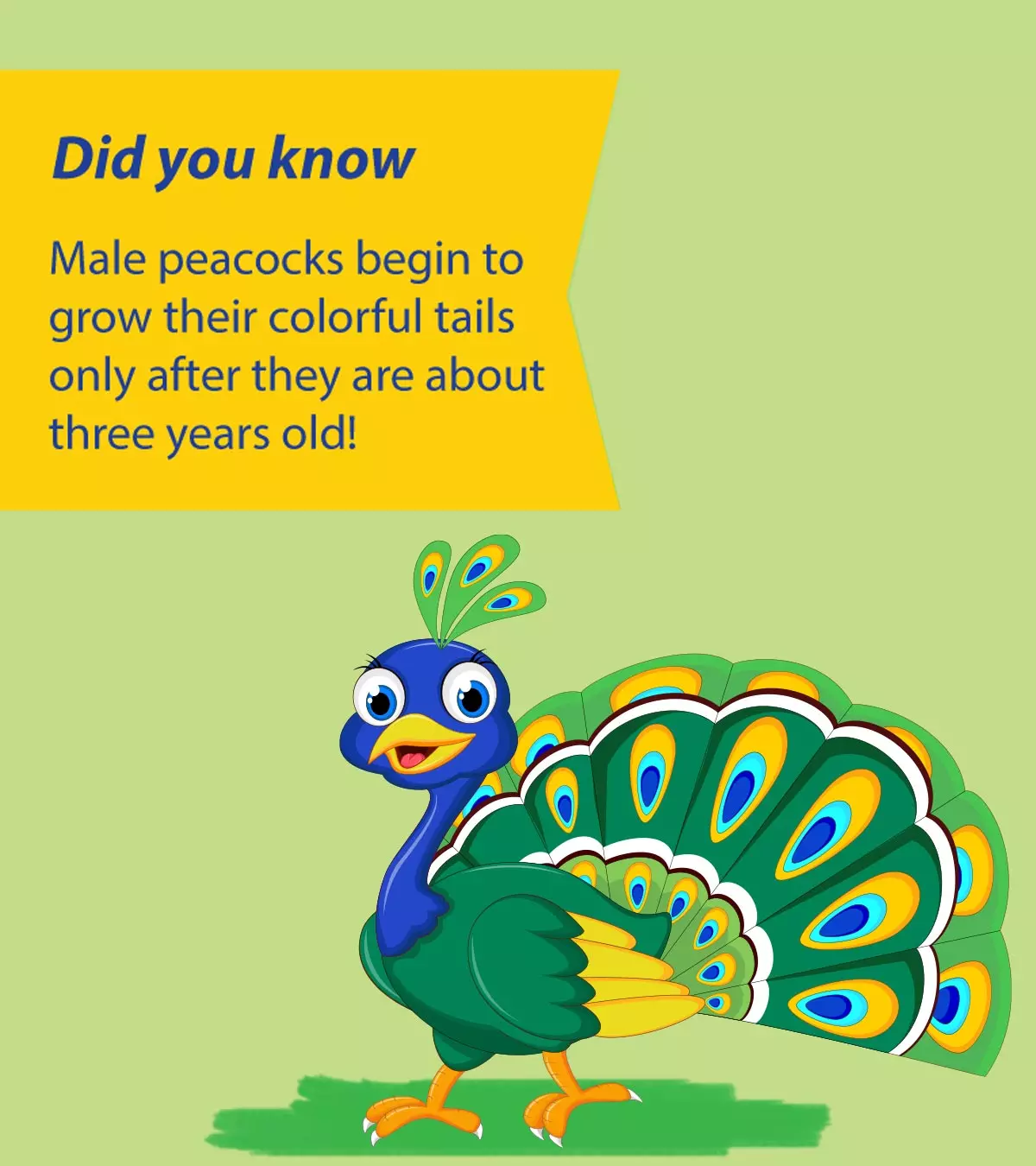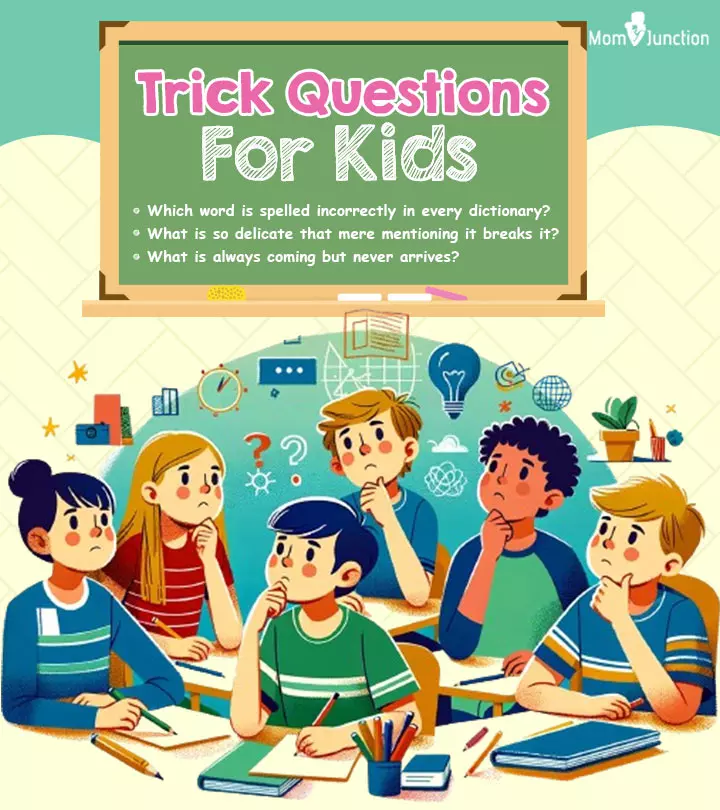
Image: Shutterstock
Teaching children to share can make them humble, empathetic, and cooperative. It can also improve their social skills and promote cooperation and strong interpersonal relationships. It may feel like a difficult task for all children initially. Be it their favorite toy, pillow, or snack; most children are quite possessive about their belongings, and until a certain age may not developmentally understand the concept of sharing.

A child’s attention span is pretty short, so they might even stop playing with that toy after fighting with you for it with all their might. Hence, educating the kids to share early on in their lives goes a long way. Here we have listed some easy tips and tricks that you may use to teach your little one about how sharing is a good personality trait. However, it is important to remember that as adults, we are not always required to share, nor do we always like sharing.
Key Pointers
- Teaching children the importance of sharing from an early age will help them socialize better and learn about cooperation while playing.
- Allow them to gradually learn its value as they may not be willing to share their dearest possession in the first instance.
- You may show them examples of sharing by doing so yourself and appreciate them whenever they share with others.
Why Is Sharing Important For Kids?
Children should imbibe the virtue of ‘sharing’ for a fulfilling future. It helps them make new friends, maintain relationships, play cooperatively, and learn to negotiate and cope with disappointments in the long run. They may also begin to understand that if they share, their gesture may be reciprocated.
Sharing is an integral part of socializing with others, so it is all the more essential when your child sets foot in preschool or kindergarten. It paves the way towards a harmonious playtime and cultivates strong bonds.

For toddlers, the concept of sharing is new. They cannot keep a check on their emotions as they have merely started learning the beginning ideas of sharing. Don’t be surprised when your child throws a tantrum, refusing to share. Setting any expectations at this age is unrealistic. Try encouraging them to learn and practice. Until approximately age three, it is difficult for them to cognitively understand the concept of sharing.
When they turn three years old, they start familiarizing themselves with what sharing and turn-taking are. They understand that sharing is a fair practice, but they don’t necessarily want to give up something for someone else’s sake. They learn the concept of sharing and understanding others emotions and thoughts gradually. You can inspire them, but do not push them.
When they enter school, they have a decent understanding of fairness and sharing. They become more tolerant and patient than they were. Children at this age may prefer selective sharing. Like an adult, a child might want to reserve some possessions exclusively to themselves. They might not like to share their treasured teddy or blanket like you would not want to part away with the jewelry piece or heirloom shawl you received from your mother. Respect your child’s right to their prized possessions and support their choices.
 Point to consider
Point to considerHere are a few ways in which you can encourage your child to share.
1. Be a role model
Modeling sharing in front of the child is essential. They usually tend to imitate what they observe and see in their environment. Set an example by demonstrating it. Let them know you share your books with your friends and give away your old clothes and toys to the needy. Also, share snacks with family members in front of them. Throw light on simple actions and act as a role model for your children.
2. Teach the concept of taking turns
As and when your child is ready to learn, teach them the concept of turn-taking. While you are playing, keep passing a ball or a toy back and forth and mention, “your turn now.” Follow it up with “mom’s turn now” to encourage and familiarize them with the whole idea of sharing.
3. Praise actions of sharing
It is always good to remind children that being generous and compassionate towards others is a good deed. If they agree to share something, appreciate their action. They will feel motivated, and appreciating their actions will make them want to do it over and over again.
4. Plan and be proactive

If you know that your child will have trouble sharing toys during a playdate, proactively ask the playmate’s parents to send some toys. Some children find it difficult to resist new toys. When another child shares their toys, your little one will understand they have to share their toys too. Similarly, if your child has a playdate with a child who is unwilling to share, take toys along. When someone else shares with your child, talk with your child about how that felt and help them see they will make others feel good when they share with them.
5. Never force a child to share
Create the right environment that motivates your child to share.
For you, a toy might not hold the kind of significance that it has for a child. It could be a prized possession for them. If they are not listening to you, try respecting their possessiveness while you imbibe the virtues and importance of sharing with them. Observing how your child behaves in a group setting will give you a perspective into what kind of guidance they need.
6. Give your child opportunities to share
To reinforce sharing habits in children, you can use older children as role models. Rather than instructing them, encourage your child by gently guiding them. If a toddler is on the receiving end of a good deed, they will likely reciprocate or imitate the gesture sooner or later. It teaches a valuable lesson to the toddler that sharing is caring, and you will be relieved to see your little one come through with the best behavior.
7. Introduce time-sharing activities
Children can keep taking turns to have a toy for a specified time and then hand it over to the other child when the buzzer goes off. Keep reassuring them that everyone would get a chance. It would not be an easy ride, so be patient. It will take them a few cycles before they hand over the toy with a smile. Gradually, it will become a practice, and they will learn a valuable lesson for life that holding up gratification can be meaningful.
If this trick doesn’t help, place the toy on the shelf. Explain to them that neither gets to lay their hands on the toy if they don’t like to share. They might initially fume and froth but will soon realize that sharing the toy is better than sacrificing it completely. They will end up imbibing the virtues of compromise and cooperation.
 Quick tip
Quick tip8. Play didactic games

Games such as “Share Daddy” help. You can place your two-year-old on one knee and the other child on the other. It will teach them that they have to share their daddy. Similarly, you can give some goodies, including toys, flowers, or crackers, to your two-year-old and ask them to give one to everyone around. The message conveyed here is that sharing spreads joy and is a way of life.
9. Stay connected to the child
It is a proven fact that a child does what they see and gives what they get. Children who are attached to parents in the initial years tend to share in the following years. An attached-parented child has a secure self-image, and their need to validate their worth is relatively low. Thus, they require lesser attachment objects.
10. Make it fun
Try to include more cooperative games and activities than competitive games where they focus more on winning. You can do jigsaw puzzles together and add pieces taking turns. You can also water plants or clean the room together.
11. Protect your child’s interests
If your child has a soft corner for a particular toy, protect and respect that attachment. At the same time, teach the importance of being generous. It is healthy for a child to be possessive about some toys. Guard that possession and slowly ease them into sharing. Before a playdate, check with your child which toys they are willing to share. Ask the playmate to get some toys too so that they can learn the art of sharing.
12. Show examples in everyday life

When in public, point out how people share and help each other and why it is considered to be good manners for kids. Show them that it is not just toys and food that need to be shared, but other things, such as love, respect, and affection. Teach them the importance of compromising and cooperating through real-life examples.
13. Teach them to spread joy
Make sure that your children grow up to be fine human beings who spread love and joy in the world. A simple act of sharing will mold their personalities and teach them to consider others’ feelings and emotions.
14. Play group games
Playing with other children is like attending a special school where your child learns the crucial skills of being part of a team. In these group games, children learn the art of sharing, negotiating, and problem-solving, creating a little community. Unlike formal settings, there are no strict rules. It is more about everyone wanting to play with similar toys and occasionally trading them. Through these shared experiences, your child not only learns to share toys but also to exchange ideas. Group activities foster cooperative play and help them understand social rules. So, when kids engage in these playful adventures, they are not just having fun, they are on a journey of discovering the magic of sharing, teamwork, and building friendships (2).
Frequently Asked Questions
1. What activities for kids promote sharing?
Some of the interesting activities to encourage sharing among children include passing the ball, singing a sharing song, painting a picture with others, roll ball competitions, and parachute stories. Such cooperative games also promote teamwork and mutual understanding. Children learn to empathize, cooperate, and communicate with each other and understand the significance of helping one another for a common goal.
2. How do I deal with kids that don’t want to share?
If your child refuses to share his food or anything else, do not force them to do so. Your child may refuse to share because it is too special or dear to them. Instead of forcing them to share, try to incorporate sharing activities into their daily routine, nurture them to share, and use every opportunity at home to teach them the benefits and outcomes of sharing.
3. What are the developmental milestones associated with sharing?
Two important social skills or milestones that develop while learning to share may be parallel play and taking turns. In the early stages, when children do not quite understand the concept of sharing, they may engage in parallel play, where they learn to play alongside each other without much interaction or sharing. Gradually they may learn to be patient and wait their turn as they pass the toy back and forth among themselves (3) (4).
4. What are some common challenges parents face when teaching children sharing?
The most common challenges that arise are impatience, possessiveness, tantrums, and competition for attention or things. Children might feel too attached to their belongings and not want to give them up or may be unwilling to share as they might think they will lose out to their friends or siblings. So, encourage taking turns, model sharing behavior, and reward and praise positive behavior to help children develop the habit of sharing.
The best method of teaching children to share is to act as a role model and value sharing. To familiarize the child with the concept of sharing, you might teach them to wait for their turn while playing or doing other activities. Plan ahead of time and provide opportunities for children to share, but never force them to share their toys, snacks, or other objects. Teach sharing through plays and explain them in fun ways to help them remember. Sharing is one of the habits that parents should teach their children as it helps spread joy and is a part of good behavior. These basic behavioral training and mentoring can mold them to become kind and empathetic individuals when they grow up.
Infographic: Simple Sharing Activities For Children
Sharing is caring. Parents and elders should teach the act and importance of sharing to children from a young age. Although children learn to share gradually, you may begin teaching them sharing with simple activities, as outlined in the infographic below.
Some thing wrong with infographic shortcode. please verify shortcode syntax
Illustration: Effective Ways To Teach Kids Sharing And Its Importance

Image: Stable Diffusion/MomJunction Design Team
Do you struggle to find ways to teach your kids how to share? This video provides techniques like using games and asking kids to speak on something for this purpose.
References
- Developmental Stages of Social Emotional Development In Children.
https://www.ncbi.nlm.nih.gov/books/NBK534819/ - The importance of play in early childhood development.
https://www.montana.edu/extension/health/documents/MT201003HR.pdf. - Sharing is Caring…AND a Developmental Milestone.
https://www.greatkidsinc.org/sharing-is-caringand-a-developmental-milestone/#:~:text=The%20American%20Academy%20of%20Pediatrics,age%20(MacLaughlin%2C%202017). - Sharing and learning to share.
https://raisingchildren.net.au/toddlers/behaviour/friends-siblings/sharing
Community Experiences
Join the conversation and become a part of our nurturing community! Share your stories, experiences, and insights to connect with fellow parents.
Read full bio of Ashley Baldwin
Read full bio of Trisha Chakraborty
Read full bio of Harshita Makvana
Read full bio of Shinta Liz Sunny
















